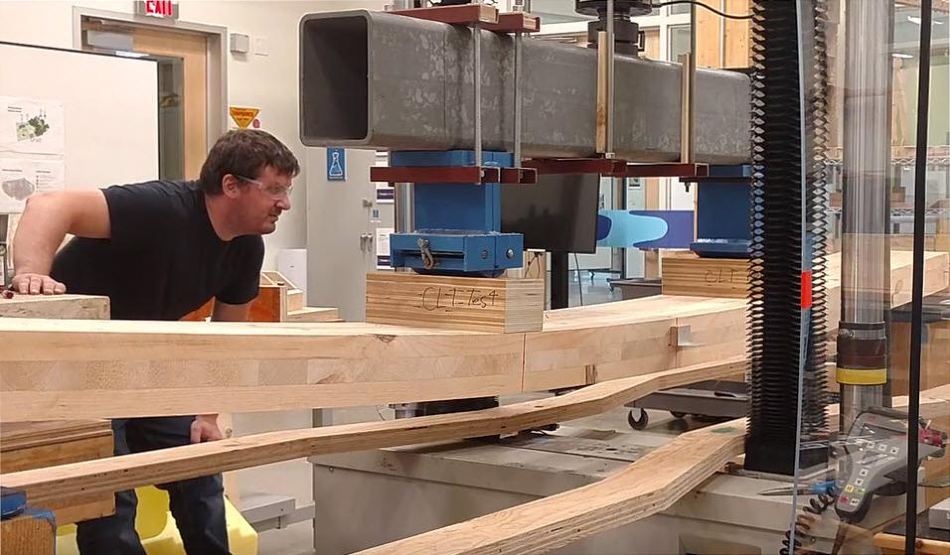Feb 28 2020
A timber engineer at the University of Massachusetts Amherst has discovered that two tree species, native to the Northeastern United States, are structurally strong for use in cross-laminated timber (CLT).
 Panels of CLT are placed in a strength-testing machine. Image Credit: Peggi Clouston/UMass Amherst.
Panels of CLT are placed in a strength-testing machine. Image Credit: Peggi Clouston/UMass Amherst.
CLT is a new, innovative type of building material that exhibits desirable sustainability properties. The study outcomes have been reported in the Journal of Materials in Civil Engineering and propose that these trees—the eastern white pine and eastern hemlock—could promote local markets for CLT.
According to the study, through the manufacture of CLT—a kind of mass timber used for the construction of floor, roof, and wall—could enhance rural and forestry economies, create jobs, and support better management of forestry, which is an approach toward tackling climate change.
“This is the future—prefabricated, panelized wood,” stated Peggi Clouston, lead author of the study and professor of wood mechanics and timber engineering in the School of Earth and Sustainability. “It’s far more efficient and there’s far less waste than site construction. It’s less time- and labor-intensive than building with cast-in-place concrete” and exhibits a considerably lower carbon footprint.
Clouston’s initiative in advanced wood construction technology played a crucial role in the construction of the John W. Olver Design Building at UMass Amherst, a demonstration of best practices in sustainability.
In 2017, the structure was opened to accommodate academic departments and offices and was regarded as the most technologically advanced CLT building in the United States. The Design Building was built using only FSC-certified CLT, which ensured it was obtained only from responsibly managed forests that offer social, economic, and environmental benefits.
We wanted to show the world how to build a contemporary mass timber structure, and we are doing so. Groups have come from as far away as Taiwan to see it.
Peggi Clouston, Professor of Wood Mechanics and Timber Engineering, School of Earth and Sustainability, UMass Amherst
The eastern white pine and eastern hemlock were tested by Clouston and her colleagues in the UMass Wood Mechanics Lab at the Olver Design Building. The composite building panels were created bonding together wooden boards from pine and hemlock trees that were grown in the region.
We then broke them in a strength-testing machine to find out if they would be safe to use in a university-size building.
Peggi Clouston, Professor of Wood Mechanics and Timber Engineering, School of Earth and Sustainability, UMass Amherst
The results were analyzed by the team by comparison with engineering requirements, and it was demonstrated that both tree species complied with building standards, where eastern hemlock outclassed pine.
According to Clouston, it is a main forest-management priority to salvage wood from eastern hemlock since the trees are attacked by an insect called the hemlock wooly adelgid. “The insect doesn’t harm the wood, but it kills the tree, which in five to 10 years will rot and fall down, becoming hazardous fuel for forest fires,” she added.
Moreover, eastern hemlock is regarded as low-value since it is susceptible to a wood defect known as ring shake and is seldom used in structural framing.
Turning this particular species into CLT turns a very low-value material into a very high-value building product.
Peggi Clouston, Professor of Wood Mechanics and Timber Engineering, School of Earth and Sustainability, UMass Amherst
For architects, spotting low-carbon construction materials is a rising trend, and this is the right time to promote CLT production in the Northeastern United States, the study concludes.
“The testing we did shows that anyone who would want to invest in a local plant has a reason to do so,” stated Clouston, whose pioneering study recently featured in a Washington Post story. “The prospect of being able to use local wood in CLT and manufacture it locally makes it all the more sustainable by avoiding the environmental cost of transporting the material long distances.”